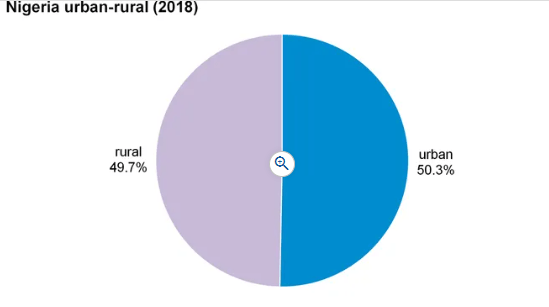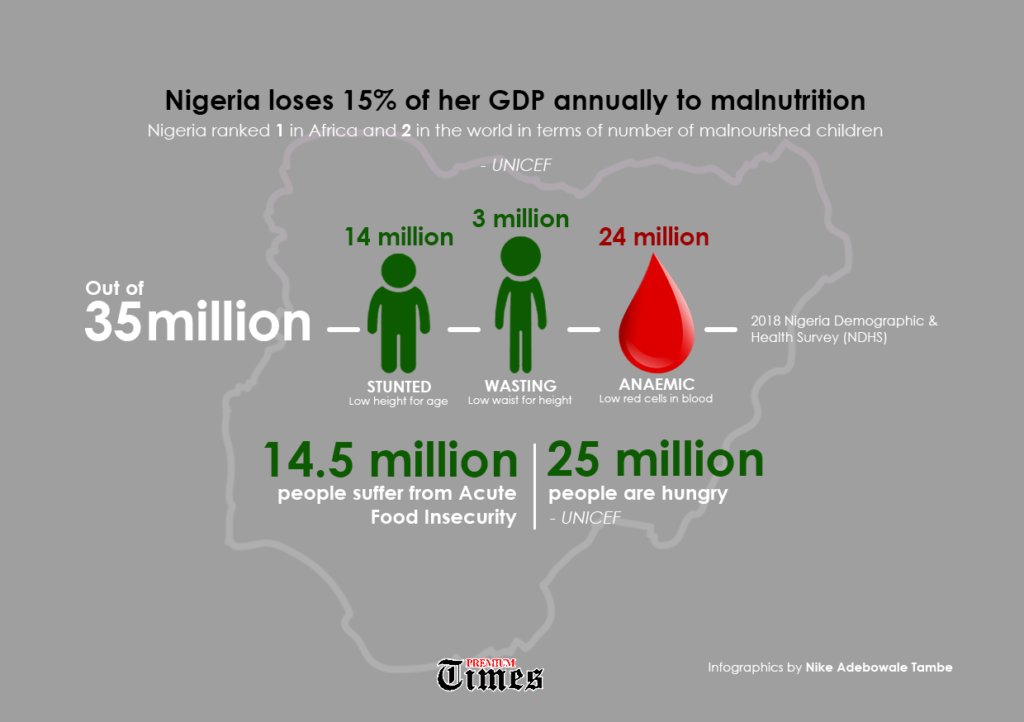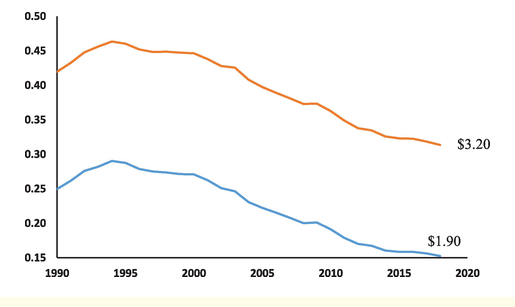
Table of Contents
SUSTAINABLE DEVELOPMENT GOALS
Introduction
Sustainable development growth refers to the approach of creating economic value without reducing the natural resources and environment for the use of future generations. Economic development needs appropriate utilization of the agricultural land, market and technology. Here Nigeria is a chosen African country having geographic, climate, and population diversity. As per Kuhe et al., (2019), the total population of Nigeria is estimated at 217,905,704 and almost half of them are living in rural regions. The sustainable development issues of this country are as follows:
Diversified population: The pattern of population is mainly a combination of ethnic groups in this area and they have less knowledge about the efficient utilization of resources for less education. There are different ethnic groups of 250 minimum. Even the high value of rural people also reduces the chance of development.

Figure 1: Percentage of Rural settlement in Nigeria
(Source: Akpafun et al. 2020)
Less share of Gross Domestic Product: As it is a developing country, the fertility and mortality rate both are high. As per Abikoye et al. (2021), 42.1% of their population is under the age of 15 and they are not in the workforce. Hence it reduces the earning of Nigeria and induces the threat of poverty and hunger.
The economics of hunger and the human cost
Hunger is the direct function of poverty that is created through unequal income sharing. Awotokun et al., (2020) have stated that it increases the gap between per capita earning of each group. Less monetary holding induces the economics of hunger and creates huge cost for the population of Nigeria. There are different regions of Nigeria that comprises south, central, North and among them the cost of hunger is highly noticeable. As per Ozor and Mbohwa (2020), almost 4.4 million people in that region are at great risk of food security. They have also mentioned that 775,000 people are under high extreme risk. Among the above mentioned reasons, covid-19 impacts on the economic stagnation and that increases the hunger of Nigeria and makes almost 70% people below the poverty line (Orji et al., 2020). The impact of this hunger in Nigeria is not only related to the creating cost to the adult population but it also adds cost to the children of this country as well and those costs are as follows:
Hunger and the malnutrition:
Hunger is the function of extreme poverty and it results in the inability of achieving food, especially nutritional food for the household people. Nigeria also suffered from this hunger issue. Malnutrition is a threat to any economy to include sustainable development. Nigeria secured the highest place for the number of diminutive babies aged under five in the whole region of Sub-Saharan Africa. The children are mostly suffering from the underweight, stunted and the issue of abnormality due to this hunger issue. As per Uche et al, (2018), 37% of the Nigerian children under aged five have been found stunted in the worldwide data. Sustainable development demands human power to understand and utilize technological improvement in their agricultural sector for high production. In this country there are high fertility rates and most of them have an underdeveloped brain, low mental ability of learning. This reduces the school performance of the children in Nigeria and more than 10 million children have no primary education in Nigeria. As per Fayomi and Ehiagwina, (2019), low attendance of school reduces the opportunity of human capital and it engages 0.7 grade loss in school. It refers to an almost seven-month delay in school performances and almost 45% reduction in the whole earning of life.

Figure 2: Value of Economic Loss due to Hunger in Nigeria
(Source: Onyibe, 2019)
The above mentioned figure has described that a total of 35 million people are suffering from malnutrition in Nigeria and that resulted in almost 15% loss in their GDP earning. Another economic cost of hunger is the increasing inflation rate. Food inflation in this country rises to 20.32% from 20.25% in 2018 reducing the purchasing capacity of Nigerian people.
Conflicts regarding Hunger:
The hunger crisis included conflicts in connection with the high food inflation rate. Price rise engages a conflict between the farmers and herders in the aspect of the agricultural sector. As per FO and NA, (2022), the insurgency in Boko Haram is another rise of conflicts due to hunger. This resulted in high displacement in Nigeria. Adelaja and George, (2019) have stated that the states of Borno, Adamawa and Yobe come under high pressure of population displacement in Nigeria. Almost 8.7 million people of Nigeria have experienced displacement. The “acute food insecurity” increases to 265 million of people from 135 million in 2019 due to famine (Oyekale and Oyekale (2021). With this insufficient food provision, the context of malnutrition is again added and it is estimated that almost 7.9 million people of the working aged people have suffered from stunted growth and it adds a 2 billion dollar economic cost to the Nigerian economy. Due to the displacement in another ill-treated community the provision of aid also reduces.
Policy implementation
Micro Financing Approach:
In Nigeria, the main issue of hunger and poverty is created through the unequal income share among the population. The people have less knowledge and low monetary holding restricts the technological inclusion that effectively increases the opportunity of higher production. Micro Financing is a strategy used for the Nigerian people that are out of the provision of the traditional economic sector. As per Mustapha et al., (2019), micro financing is the assurance of giving a small amount of monetary value that encourages the small scale farmers to invest in their agricultural practices. On the other hand, as per Abdullahi et al., (2018), those interested about starting any entrepreneurship can also have the access of loans from micro financing for sustainable development approaches. It is a new model of the Nigerian economy to provide security of the banking service to the area of low income individuals. It reduces the unemployment rate among the population and thus the threat of poverty reduces.
It includes several programs as well and “Cash transfer program” is one of them. This program has planned to offer cash for the severe food shortage in Nasarawa state of Nigeria due to drought. As per Neves et al., (2022), this cash transfer program is established to provide support to the low-income people of Nigeria who are unable to balance their cost with high food inflation rate and other household needs. Thus, the efficient provision of food can reduce poverty and hunger among the Nigerian population. These strategies are related with the development theory of “Neoclassical growth”. As per Huang et al., (2020), neoclassical observed that for economic development four key elements of macro economy should be improved and those are capital, labor, technology and entrepreneurship. Now the micro financing policy supports monetary inclusion that is considered as the capital improvement and these all are helpful for the entrepreneurial activities as well.
“Nigeria Zero Hunger Strategic Review”:
Nigeria again forms a systematic plan that helps this country towards the zero hunger development strategy. According to Okike et al., (2021), in 2015 Nigeria promoted a set of 17 “Sustainable Development Goals” (SGDs) to support agricultural potential. This program had a plan to lift up almost 13 million people from hunger. “World Food Program”, “African Development Bank”, are included in this goals setting program for funding (Otekunrin et al., 2019). Another component of neoclassical growth is the improvement of labor. This needs a healthy internal workforce of a country. It is understood that the young aged people of Nigeria are suffering from mental disability and other malnutrition diseases. In this context, the policy of this strategic review has been established to remove hunger by 2030. Cheo and Tapiwa, (2021) have stated that this policy is the sum up of “Benue State Development Plan” and “Collective Vision for New Benue”. This policy is taken to strengthen the agricultural production that improved the “agricultural driven industrialization”. On the other hand, stakeholder engagement enables rural infrastructures. It encourages production and improves employment that indirectly reduces the malnutrition approach.
Effectiveness
In the article of Abioye and Ogunniyi, (2018), the sustainable development goals are discussed in depth and it is observed that the planning of this goal setting program is implemented effectively and immediately among the four states of the Nigerian Federation. Those are Benue, Ebonyi, Ogun and Sokoto in the month of January 2017. The numbers of states are continuously increasing and it is noticed that in 2019 another eight states have been included in this Synthesis Report. As per Abdullahi (2018), in the starting of January there are inclusion of almost 36 states of Nigeria for food security funding including Abuja. The Minister of health, UN agencies, State Governments and other legislature supporters also backs this report program.
Another article prepared by Okike et al., (2021), has engaged the discussion about the effectiveness of the Sustainable Development Goals program. In this paper, some difficulties in case of policy implementation are addressed and those are funding issues and human power for systematic implementation. Hence, this paper highlighted that these constraints can be mitigated with the sharing of information among different states. Not only that, as per Odozi et al., (2019), internal coordination and effective support from international or national agencies both are helpful to mitigate the strategies while implementation. For this, this policy followed effective partnership with many private financial sectors and NGOs such as UNDP, FAO, IFAD and the World Bank. Thus, food security is highly maintained to integrate their objective of zero hunger in Nigeria. This research also observed that the partnership encourages the responsibility of the country to address agricultural development for reduction of hunger.
As per the research of Huang et al. (2020), it has also estimated that the policy of synthesis report has also reported that double productivity can be obtained through the area of this, Nigeria has formed a well-thought-out plan to aid in the growth of this nation so that it is completely free of hunger. Nigeria, which has great agricultural potential, reportedly proposed a set of 17 “Sustainable Development Goals” (SGDs) in 2015. 12.9 million Individuals were expected to be rescued from famine thanks to this initiative. It doubles the agricultural production that enables 42.1% of their population to be children less than 15 years old, and this age group is not participating in the labor force. As a result, it has the effect of lowering the earnings of Nigeria and increasing the risk of poverty and famine.
On the other hand, there are several micro financing banks formed in Nigeria. Their effectiveness is addressed in the area of employment opportunities. In the paper of Odunjo et al., (2018), it is discussed that micro financing enables capital inclusion in the Nigerian economy to support the small scale farmers and the low income families as well. In this paper it is estimated there are 39.9% of new entrepreneur activities occurring and that offers employment to almost 750,000 people in those entrepreneurial organizations.

Figure 3: Reducing Poverty Gap through small-scale entrepreneurship for micro-financing in Nigeria
(Source: Odunjo et al., 2018)
Employment increases the monetary holding among people and that reduces poverty among them. As per the above figure, micro-financing helps to reduce the poverty level of Nigeria.
Another study made by Tafamel (2019) has also stated the positive impact of micro-financing policy in the Nigerian economy. As per their opinion the hunger index is mitigated through effective poverty eradication. Micro financing raises their income level even in the situation of having a high inflation rate. It reduces the level of poverty among small income groups and the value is reduced to 0.15% in 2018 from 0.27% in 2015 only by this micro-financing approach. The eradication of poverty improves the health condition of new born people and it secures the efficient labor supply to the economy that effectively raises the sustainable growth for the future generation as per the neoclassical growth theory.
Conclusion
This discussion is made on the basis of the economic issue of Nigeria that restricts them to add value in a sustainable development approach. Then hunger and human cost with some mitigating policies are also discussed. In this example, Nigeria is an African nation selected because of the variety it has in terms of its geography, climate, and people. over 4.4 million people in that area are severely threatened by a lack of food. Population diversity and the lack of per capita income is addressed as an economic issue. It was also said that 775 thousand individuals are in imminent danger. In addition to the aforementioned factors, Nigeria’s economic slowdown because to covid-19 contributes to the country’s high hunger rates and pushes over 70% of the population below the poverty line.
Worldwide statistics shows that 37% of Nigerian children under the age of five are stunted. High agricultural output necessitates that people learn how to take advantage of technical advances in the agricultural industry, which is essential for a sustainable future. There are a lot of babies being born, and most of them don’t have very good brains or much of a capacity for learning. As a result, more than 10 million Nigerian children are not enrolled in school and are unable to complete the first grade. Another hunger cost is added in the area of conflicts where it is seen that the Boko Haram uprising is just one more example of a war fuelled by food shortages. Nearly 8.7 million Nigerians have been uprooted from their homes. Due to famine, the number of people experiencing “acute food insecurity” rises from 135 million in 2019 to 265 million in 2020. There are some policies as well that are engaged by Nigeria and those are micro financing and the Synthesis report. The “Cash transfer programme” is only one of the many included programmes.
Nasarawa state in Nigeria has been hit hard by a drought, and this initiative aims to provide emergency funding to help alleviate the resulting food crisis. Neoclassicals recognised that four crucial components of the macroeconomy—capital, labour, technology, and entrepreneurship—need to be strengthened in order to foster economic growth. Currently, microfinancing policy promotes financial inclusion, which is seen as an increase in capital and is beneficial to business endeavours. On the other hand, zero hunger strategic review makes partnership and collaboration beyond the national regions. In this aspect, it is also observed that 36 countries are engaged in this policy treatment. Again, the end of the discussion has also examined the effectiveness of these policies with five other journals. Those all promoted positive usage of these policies in Nigeria. Through microfinance job opportunity rises and synthesis approach enables double agricultural production. Hence, sustainable goals require all the citizens of this country to act together and follow the policy action in a quick manner to remove hunger by 2030 and it is not an easy practice due to the threat of high level of poverty and climate change.
References
Abdullahi, N.A., 2018. Cooperative Societies and Microenterprise Financing in Nigeria: A Literature Approach. Journal of Finance, Accounting & Management, 9(1).
Abikoye, G.E., Adekeye, O., Adeusi, S., Henry, G.E. and Sylvester, N.P., 2021. Patterns Of Use, Perception of Risks and Experienced Effects of Drugs: Exploring the Hard-To-Reach in Uyo, Nigeria. NIGERIAN JOURNAL OF CLINICAL PSYCHOLOGY, 11(1&2), pp.106-118.
Abioye, O. and Ogunniyi, A., 2018. Coldspots and Hotspots of Agriculture in Nigeria; Any Hope for Youth and Women?
Adelaja, A. and George, J., 2019. Effects of conflict on agriculture: Evidence from the Boko Haram insurgency. World Development, 117, pp.184-195.
Akpafun, S., Ndinwa, G.C. and Chukumah, C.O., 2020. Evaluation of Environmental Awareness Level among Stakeholders in Rural and Urban Communities, Southern Nigeria. International Journal of Climate Research, 4(1), pp.1-15.
Awotokun, K., Nwozor, A. and OLANREWAJU, J., 2020. CONFLICTS AND THE RETROGRESSION OF SUSTAINABLE DEVELOPMENT: THE POLITICAL ECONOMY OF HERDERS-FARMERS’CONFLICTS IN NIGERIA. Humanities & Social Sciences Reviews, 8(1), pp.624-633.
Cheo, A.E. and Tapiwa, K.A., 2021. SDG2-Zero Hunger: Food Security, Improved Nutrition and Sustainable Agriculture. Emerald Group Publishing.
Fayomi, O.O. and Ehiagwina, B.S., 2019, July. Assessing the migration dynamics in the context of agriculture and human development in Nigeria. In AIP Conference Proceedings (Vol. 2123, No. 1, p. 020024). AIP Publishing LLC.
FO, D., NO, Y. and NA, D., 2022. TERRORISM AND FOOD SECURITY: EVIDENCE FROM BOKO HARAM INSURGENCY IN NORTHEAST NIGERIA AND INTERVENTIONS OF UNITED NATIONS HUMANITARIAN AGENCIES AND OTHER STAKEHOLDERS.
Huang, C., Zhao, X., Cao, J. and Alsaadi, F.E., 2020. Global dynamics of neoclassical growth model with multiple pairs of variable delays. Nonlinearity, 33(12), p.6819.
Kuhe, D.A., 2019. The impact of population growth on economic growth and development in Nigeria: An econometric analysis. Mediterranean Journal of Basic and Applied Sciences, 3(3), pp.100-111.
Mustapha, M.B., Yusuf, B.I. and Abdullahi, A.N., 2019. Micro-financing and rural poverty reduction: A case of Rima microfinance bank in Goronyo Local Government Area, Sokoto state, Nigeria. Journal of Development and Agricultural Economics, 11(10), pp.256-264.
Neves, J.A., Vasconcelos, F.D.A.G.D., Machado, M.L., Recine, E., Garcia, G.S. and Medeiros, M.A.T.D., 2022. The Brazilian cash transfer program (Bolsa Família): A tool for reducing inequalities and achieving social rights in Brazil. Global Public Health, 17(1), pp.26-42.
Odozi, J.C., 2019. Food Systems for Healthier Diets: A Review of Literature on Transport, Storage and Trade in Nigeria’s Supply Chain.
Odunjo, V.O., Osawe, W.O. and Okoruwa, V.O., 2018. Effect of micro-credit on welfare of small scale entrepreneurs in Nigeria: A case study of Oyo state. Journal of Sustainable Development Studies, 11(1).
Okike, I., Ayoola, G.B., Ogundapo, A.T., Ojide, M., Abdoulaye, T., Dashiell, K. and Manyong, V., 2021. Nigeria zero hunger/IITA policy brief No. 3: Nigeria zero hunger strategic review-nutritional status of children under the age of 5 in Ogun state, Nigeria.
Okike, I., Ayoola, G.B., Ogundapo, A.T., Ojide, M., Abdoulaye, T., Dashiell, K. and Manyong, V., 2021. Nigeria zero hunger/IITA policy brief No. 3: Nigeria zero hunger strategic review-nutritional status of children under the age of 5 in Ogun state, Nigeria.
Onyibe, J.E., 2019. Re-thinking Ag-Sector development strategies towards zero hunger in Nigeria by 2030. Journal of Emerging Trends in Economics and Management Sciences, 10(1), pp.12-23.
Orji, A., Ogbuabor, J.E., Nwosu, E., Anthony‐Orji, O.I. and Amoji, N., 2020. Analysis of poverty correlates and multi‐dimensionality in south east Nigeria: New empirical evidence from survey data. Poverty & Public Policy, 12(3), pp.255-270.
Otekunrin, O.A., Otekunrin, O.A., Momoh, S. and Ayinde, I.A., 2019. How far has Africa gone in achieving the zero hunger target? Evidence from Nigeria. Global Food Security, 22, pp.1-12.
Oyekale, T.O. and Oyekale, A., 2021. Determinants of food insecurity during COVID-19 pandemic in Nigeria: a random effects ordered probit approach. Acta Universitatis Danubius. Œconomica, 17(6).
Ozor, P.A. and Mbohwa, C., 2020. Economic-Based Sustainability Assessment of Aluminum Roofing Sheet Manufacturing/Life Cycle and Plant Sizing in Nigeria. Procedia Manufacturing, 43, pp.277-284.
Tafamel, E.A., 2019. Analysis of the effect of microfinance institutions on poverty reduction in Nigeria. In Analysis of the effect of microfinance institutions on poverty reduction in Nigeria: Tafamel, Ehiabhi Andrew.
Uche, C., 2018. Topical review of hidden hunger and poverty profile in Nigeria: case study of Kwara state (Province) and suggested agricultural and economic solutions. Global Journal of Management and Business Research, 18(4), pp.31-35.
